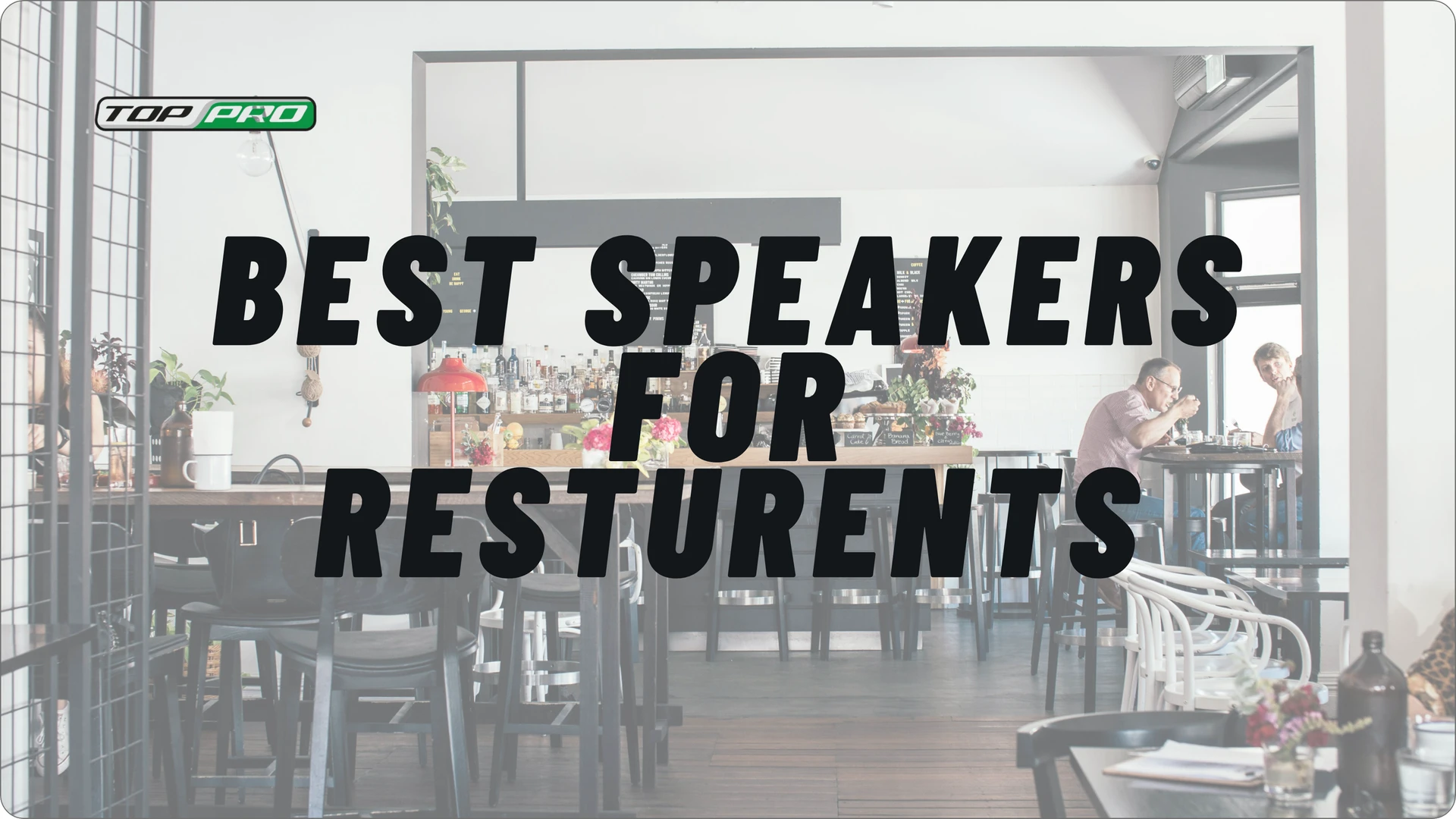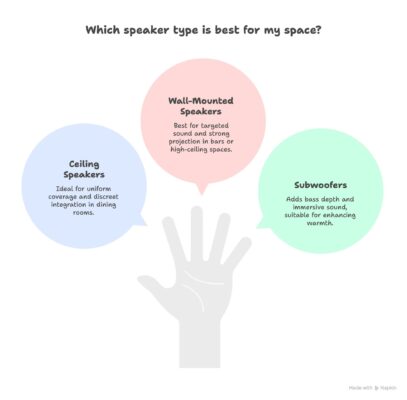Guide to Choosing the Best Speakers For Restaurant Sound Systems

Why Sound Systems Matter More Than Ever?
Most restaurants still treat sound systems as background noise. But in 2025, audio has become a key part of brand identity—just like lighting and interior design. Guests don’t just taste your food; they hear your atmosphere. And if the sound is off—too loud, uneven, or cheap—you’ll feel it in reviews and repeat business.
This guide shows you how to choose the right speakers, position them for maximum effect, and keep your sound system tuned so it works like an invisible maître d’ for every table.
What You’ll Learn
By the end of this guide, you’ll know how to:
Match sound systems to your restaurant’s size and layout
Choose between ceiling, wall-mounted, and subwoofer setups
Position speakers for even coverage without hotspots
Use tools like SPL meter apps to calibrate volume
Maintain and troubleshoot your sound system like a pro
Understanding Your Restaurant’s Sound Needs
Just like every menu has its signature dish, every restaurant has a unique sound profile.
Size matters: A cozy café may only need a pair of ceiling speakers, while a multi-room venue might require zones with separate amplifiers.
Layout matters: Bar areas often need more punch; outdoor seating demands weather-resistant speakers.
Audience matters: Families want calm, clear music around 60 dB; younger crowds often prefer livelier, bass-driven energy closer to 70–75 dB.
Pro Tip: Use a free SPL meter app on your phone to measure your restaurant’s current sound levels. Compare against the 60–70 dB comfort zone for conversation-friendly dining.
How to Pick the Perfect Speakers
Speakers are the voice of your restaurant. Choosing the wrong type is like pairing the wrong wine with a dish.
Speaker Types Compared

| Speaker Type | Best For | Pros | Cons | Verdict |
|---|---|---|---|---|
| Ceiling Speakers | Uniform coverage | Discreet, blend with décor | Less directional control | Ideal for most dining rooms |
| Wall-Mounted | Targeted sound | Adjustable angles, strong projection | Visible hardware | Great for bars, high-ceilings |
| Subwoofers | Bass depth | Rich, immersive sound | Can overpower if misused | Use sparingly to add warmth |
Case Example: A Dubai café reduced customer complaints by repositioning two ceiling speakers 3 meters apart instead of 5. The SPL meter showed balanced coverage after adjustment, with no “hot spots” near tables.
Installation & Maintenance
Why it matters
A great system poorly installed is like premium ingredients cooked wrong—it spoils the experience.
In practice
Hire a pro installer → ensures correct acoustic design.
Clean and dust speakers regularly → prevents muffled sound.
Update firmware → unlocks performance improvements.
Run quarterly sound checks → adjust to seasonal crowd sizes.
Pitfall: Many restaurants skip cable checks. Loose or frayed wiring often causes “mystery” audio dropouts. → Fix: Inspect and replace cables every 6 months.
Advanced Connections: Zones & Control
Think of your restaurant as multiple sound “zones”: bar, dining room, terrace. Each needs separate speaker control. Modern systems let you:
Adjust volume by zone with a wall panel or mobile app
Push announcements through a PA without affecting music
Balance bass differently indoors vs outdoors
Why it matters: Without zoning, guests at the bar shout over music while diners in the back barely hear it.
Troubleshooting & Quick Fixes
Uneven sound? → Check placement; add another ceiling speaker.
Distorted bass? → Lower subwoofer gain.
Dead speaker? → Swap cables first before replacing hardware.
Echo effect? → Too many reflective surfaces—add soft furnishings or use directional wall speakers.
FAQs: Expert Advice on Restaurant Sound Systems
How loud should a restaurant be?
Most restaurants aim for 60–70 dB—loud enough for atmosphere but quiet enough for conversation. Fine dining tends toward the low end; casual venues may push slightly higher. (See section: Understanding Your Restaurant’s Sound Needs).
How many speakers do I need?
It depends on size and zones. A 50-seat bistro might use 4 ceiling speakers, while a 200-seat venue could need 12+ with separate amplifiers. Use an SPL meter to test coverage before finalizing.
Where should I place speakers?
For even coverage, ceiling speakers should be spaced 3–5 meters apart. Wall speakers work best angled toward tables at ear height. Avoid placing directly above diners to reduce “hot spots.” (See section: How to Pick the Perfect Speakers).
Should I go wired or wireless?
Wired speakers offer reliability and consistent quality—ideal for permanent installs. Wireless options are flexible for outdoor or temporary setups but may suffer interference. A hybrid approach often works best.







